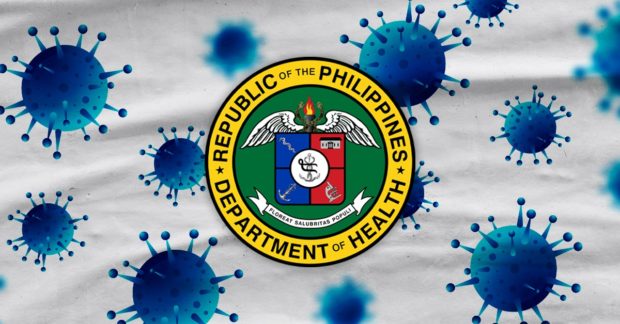
Logo of the Department of Health over a graphic representation of the SARS-COV 2, which causes coronavirus disease
MANILA, Philippines — Based on projections, Metro Manila may have up to 269,000 active COVID-19 cases by the end of September since being placed under the less restrictive modified enhanced community quarantine (MECQ), Health Undersecretary Maria Rosario Vergeire said on Saturday.
There may also be an estimated 66,000 active cases in the capital region by the end of August, she added.
However, she denied that there was a “disconnect” between the increasing number of cases and the decision of the government’s pandemic response team to downgrade the quarantine classification in Metro Manila from the strictest — enhanced community quarantine, or ECQ — to MECQ after only two weeks.
“We did not ease restrictions; nonessential establishments are not open and only those in essential sectors and the workforce are allowed outside. This is not really a disconnect; we didn’t lift restrictions and our focus is on improving our PDITR (prevent-detect-isolate-treat-reintegrate) response,” Vergeire said.
She added that while MECQ was declared, local governments should also enforce granular lockdowns when necessary.
As for the projections, Vergeire stressed that the numbers could still be reduced through improved vaccination, case detection and isolation, and people’s compliance with minimum health and safety protocols.
“These aren’t certain yet, we do not know if this will happen. If we fix our response, we can further improve and we will not reach [these numbers],” she said.
Vergeire also warned that daily case tallies were still expected to go up in the coming days, based on projections.
“We need to further prepare. We are looking at all aspects of our response so that we can prevent a further increase in the number of cases,” she said.398 more deaths
On Saturday, the Department of Health (DOH) said that it recorded 16,694 new COVID-19 cases, the new second-highest single-day tally since the pandemic began, bringing the total cases to 1,834,051. The previous second highest daily tally was 15,310 cases on April 2.
The DOH also logged 398 more deaths, the second highest number of deaths in a day, with the total death toll now at 31,596.
As for the daily case count, there remained 123,935 active cases in the country. Of this number, the majority, or 93.5 percent, were mild cases, 3.7 percent were asymptomatic, 0.7 percent were in critical condition, 1.2 percent were severe cases and 0.95 percent were moderate cases.
The DOH said that another 15,805 had recovered from the respiratory disease, bringing the total number of survivors to 1,668,520. The same case bulletin showed that the positivity rate was at 25.2 percent, meaning that of the 65,808 tests conducted on Thursday, one in every five came out positive.
Around 73 percent of all ICU beds and 66 percent of all COVID-19 ward beds were in use, while 61 percent of isolation beds were occupied, the DOH added. 5th leading cause
Meanwhile, the Philippine Statistics Authority (PSA) on Friday reported a 25-percent climb in registered deaths nationwide in the first half of the year amid a jump in the number of people succumbing to COVID-19.
At the same time, the coronavirus disease became the fifth leading cause of death.
The PSA said there were 361,480 deaths from January to June this year, compared to 289,262 during the same period in 2020.
Each of the six months posted increases in registered deaths compared to a year ago, with the biggest year-on-year rise recorded in April when NCR and four neighboring provinces reverted to ECQ due to a surge in COVID-19 infections.
The PSA data showed deaths rose by 7 percent year-on-year to 57,266 in January; up 14.1 percent to 52,792 in February; up 32.8 percent to 61,073 in March; up 49.5 percent to 66,916 in April; up 37.7 percent to 69,180 in May; and up 11.9 percent to 54,253 in June.
In a separate report, the PSA said the top five causes of deaths nationwide from January to June were ischemic heart diseases, cerebrovascular diseases, neoplasms, or more popularly known as cancer, diabetes, and confirmed COVID-19 cases.
While the top four causes also led in death statistics last year, COVID-19 climbed to fifth place with 17,156, up 1,300.5 percent from only 1,225 a year ago at the onset of the pandemic.
Declines
In contrast, the PSA data showed that other respiratory diseases posted year-on-year decline in deaths, such as pneumonia (down 32.3 percent); chronic lower respiratory infections (down 15.6 percent); respiratory tuberculosis (down 24.2 percent); and other diseases of the respiratory system (down 18.1 percent), among others.
Of the 17 regions, Metro Manila, also known as the National Capital Region, had the largest number of deaths due to COVID-19, with 9,975, or more than a third of the national total in the first half of 2021.
Among the region’s cities, Quezon City (2,176), Manila (1,528), and Pasig City (1,014) led in COVID-19 fatalities.
After NCR, Calabarzon had the second-highest number of COVID-19 deaths during the first half with 6,077, followed by Central Luzon’s 4,295.
The Bangsamoro Autonomous Region in Muslim Mindanao recorded the least deaths due to COVID-19 with 11.